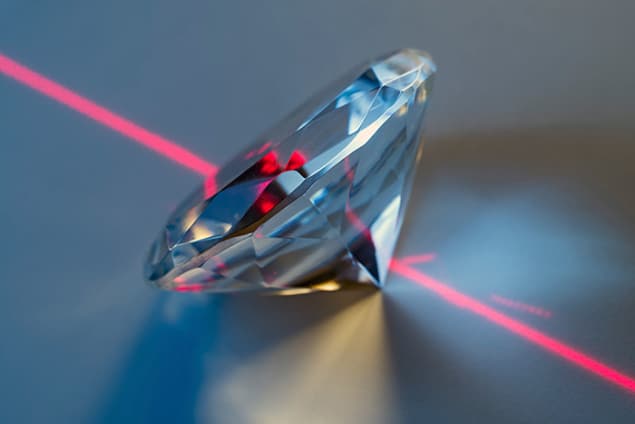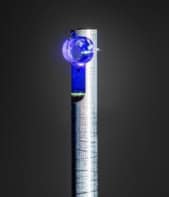
A new technique that uses diamonds and quantum logic to detect the tiny magnetic fields of single molecules has been unveiled by researchers in the US and Germany. The team then used the technique to detect nuclear magnetic resonance (NMR) signals from single molecules of a common protein. The researchers are now refining the method still further, and believe that it could reveal the currently unknown structures of some rare proteins.
Developed in the mid 20th century, NMR spectroscopy has become an immensely valuable tool for molecular analysis. “Maybe 50% of all structural information we have from complex molecules – proteins, for example – comes from NMR,” says Jörg Wrachtrup of the University of Stuttgart.
Traditional NMR involves placing the sample in a strong magnetic field, which causes atomic nuclei with dipolar magnetic moments to line up either parallel or antiparallel to the field. Radio waves of a particular frequency are then applied, causing the magnetic moments to oscillate between the two directions as they absorb the waves. The radio frequency depends on the chemical environment of the nucleus, so the absorption spectrum acts as a fingerprint of a molecule’s structure. However, there are downsides to the technique. It requires strong magnets, which are expensive. It is also a relatively insensitive technique, requiring trillions of molecules to produce a signal. As a result, conventional NMR is not useful for analysing rare proteins or looking at the variation between individual proteins in a sample.
Coupling spins
Zero-field NMR has recently been developed to make NMR spectroscopy less difficult and less expensive. Instead of studying the coupling of the nuclei to an external field, the technique records the molecular fingerprint created when neighbouring magnetic moments couple to one another. This in itself does not increase the sensitivity of the technique, but in 2013, two independent groups – one led by Wrachtrup – showed that a single nitrogen vacancy (NV) centre in diamond can detect a zero-field NMR signal from a tiny sample containing as few as 10,000 nuclear magnetic moments. A NV centre occurs when two adjacent carbon atoms in a diamond lattice are replaced with a vacancy and a nitrogen atom. NV centres are essentially tiny magnets that are isolated from their surroundings and can be manipulated using laser pulses.
In 2014, Mikhail Lukin and colleagues at Harvard University used NV centres to detect the magnetic moment of a single proton on the surface of a diamond. However, nobody had been able to detect the NMR signal from just one biomolecule.
Now, Lukin’s Harvard group has joined forces with Fedor Jelezko and colleagues at Ulm University in Germany to make two key innovations to the NV technique. First, they improved the sensitivity of the NV sensor by locating it as close as possible to the surface of the diamond. Previous research had suggested that the closer the NV centre is to the surface, the more prone it is to having its quantum coherence degraded by external noise. “But we found that, by controlling the surface very carefully, we could dramatically improve its coherence.”
Non-destructive measurement
Secondly, the researchers devised a new read-out procedure that allowed them to measure the NV centre’s electronic magnetic moment non-destructively by utilizing its quantum entanglement with the nuclear magnetic moment of the nitrogen atom. “Using this approach, the overall efficiency of read-out is dramatically increased,” Lukin says. Together, these two improvements made the technique more than 500 times as sensitive as previous attempts.
A measurement is made by fixing molecules of interest onto the surface of a diamond that has been implanted with NV vacancies. The team studied ubiquitin, which is a protein found in the tissues of all animals. The researchers were able to detect individual molecules of the protein and infer some specific chemical features. In particular, they could obtain NMR spectra of hydrogen-2 (deuterium) and carbon-13 nuclei when the proteins were enriched with those isotopes.
The team is now exploring ways of improving the sensitivity of the technique. For example, the protein molecules are currently placed in random positions on the diamond surface, and the team wants to see if placing them in specific locations relative to NV centres will lead to an improvement.
Beautiful work
“I think it is beautiful work,” says Jörg Wrachtrup. “It’s a real step forward.” However, he cautions that the NMR spectra do not have sufficient resolution to allow the researchers to actually determine the structure of a molecule. He also points out that the researchers’ proposed technique for determining structures would probably work only for very small proteins. “If I see a step that is missing,” he says, “it’s increased spectral resolution. But in principle the potential is enormous.”
The research is published in Science.



